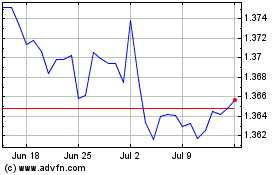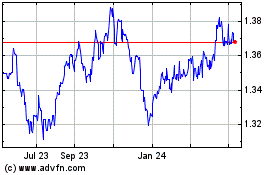U.S. Dollar Falls As Durable Goods Orders Slide Unexpectedly
March 25 2015 - 11:01AM
RTTF2
The U.S. dollar slipped against its major rivals in New York
morning deals on Wednesday, after data showed that durable goods
orders unexpectedly decreased in the month of February.
According to a report released by the Commerce Department,
durable goods orders fell by 1.4 percent in February following a
downwardly revised 2.0 percent increase in January.
The drop in orders came as a surprise to economists, who had
expected orders to climb by 0.7 percent compared to the 2.8 percent
jump that had been reported for the previous month.
Excluding a 3.5 percent drop in transportation orders, durable
goods orders still fell by 0.4 percent in February after sliding by
0.7 percent in January. Ex-transportation orders had been expected
to rise by 0.3 percent.
Federal Reserve Bank of Chicago President Charles Evans said
inflation remains too low to justify an interest-rate increase in
2015, even though economy is growing and has made progress in
reducing U.S. unemployment.
"I see no compelling reason for us to be in a hurry to tighten
financial conditions until then," Evans said to the Official
Monetary and Financial Institutions Forum in London.
"Economic conditions are likely to evolve in a way such that it
will be appropriate to hold off on raising short-term rates until
2016."
The greenback depreciated to 119.23 against the yen, down from
an early high of 119.82. The greenback is likely to find support
around the 118.7 mark.
The greenback, having advanced to a 5-day high of 1.4830 against
the pound at 7:45 pm ET, eased back to 1.4953 after the data. If
the greenback continues slide, it may eye support around the 1.50
region.
U.K. mortgage approvals rose to a five-month high in February,
data from the British Bankers' Association showed.
The number of mortgages approved for house purchases rose to a
seasonally adjusted 37,305 in February from 36,517 in January. This
was the highest since September 2014.
After climbing to 1.0900 against the euro at 7:45 pm ET, the
greenback changed direction with pair trading at 1.1013. Extension
of the greenback's downtrend may lead it to a support around the
1.12 area.
German business morale improved for the fifth straight month in
March, survey results from the Ifo institute revealed.
The Ifo Business Climate index climbed to 107.9 in March from
106.8 in February. It was forecast to rise to 107.3.
The greenback edged down to 0.9551 against the Swiss franc, off
previous high of 0.9602. Next key support for the greenback may be
located near the 0.94 mark.
Swiss consumption increased in February driven by a surge in new
car registrations, survey data from the UBS bank showed.
The consumption index rose slightly to 1.19 in February from
1.11 in the previous month.
The greenback retreated to 1.2472 against the loonie, 0.7904
against the aussie and 0.7691 against the kiwi, coming off from
early highs of 1.2521 and 0.7850 and a 2-day high of 0.7601,
respectively. The greenback may possibly find support around 1.24
against the loonie, 0.80 against the aussie and 0.775 against the
kiwi.
US Dollar vs CAD (FX:USDCAD)
Forex Chart
From Mar 2024 to Apr 2024

US Dollar vs CAD (FX:USDCAD)
Forex Chart
From Apr 2023 to Apr 2024
